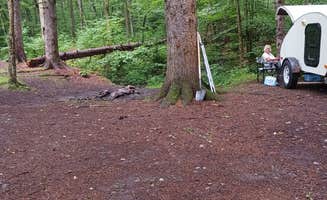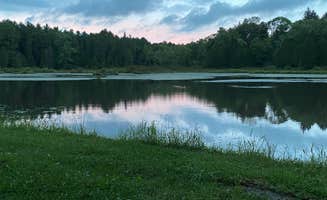Dispersed camping options near Darien Center, New York range across several state forests located primarily southeast of the area. The region features primarily northern hardwood forests with rolling hills at elevations between 1,200-2,000 feet. Winter temperatures often drop below freezing with significant snowfall that can limit forest road access from November through April, while summer brings temperatures in the 70-80°F range.
What to do
Fishing opportunities: At Palmers Pond State Forest, the pond offers secluded fishing spots. "Lots of beavers to watch throughout the day," reports one visitor, making wildlife observation an added bonus while fishing.
Hiking access: The Finger Lakes Trail runs through Boyce State Forest, providing backpackers with primitive camping options. "If you walk/hike 1/2 mile you will find a lean-to with fire pit and privy," notes camper Alan C.
Creek exploration: Several sites at Camp Seneca are positioned near a creek, offering opportunities for wading and water play during warmer months. "We picked the biggest site next to the creek," shares Kevin C., highlighting the water access available at select sites.
What campers like
Secluded camping spots: The privacy at these primitive sites ranks highly among visitors. "I drove out from Wisconsin and was the only one there. Threw up the tentsile tent over looking the pond on the south side," writes Mitch P. about his experience at Palmer's Pond.
Natural surroundings: The undeveloped forest settings provide authentic outdoor experiences. "No electricity or water hook ups, very secluded, has a pond to fish in, by far my most favorite place to camp," explains Casaundra H., emphasizing the rustic camping experience available near Darien Center.
Tree cover: Dense forest canopy at several sites offers natural shelter. Kevin C. notes about Camp Seneca: "The tree canopy over our site was dense enough that we did not get very wet when it rains," providing natural protection from light precipitation.
What you should know
Access road navigation: Forest road conditions vary significantly and some require specific approaches. "Do not take Palmers pond road. When you get off of Interstate 86 you will want to take turnpike rd to south road," advises Sydney M., noting that "There are not any lights to show the sign so it's kinda hard to find."
Seasonal pond levels: Water features may fluctuate throughout the year, affecting site desirability. "The pond was dried up when we got there so that was kind of a bummer," reports Sydney M. about a late October visit.
Trail conditions: Boyce State Forest trails can become waterlogged during wet periods. "Trail was more of a stream than a trail. You'll spend more time beside the trail then actually on it," writes Zack B., suggesting visitors "bring rubber boots" or "come in dryer season."
Tips for camping with families
Site selection: For families with younger children, choosing accessible sites is important. "The written directions from other reviews were easy to follow. The road was gravel but pretty easy to drive," notes Caitlyn R., indicating that some Palmer's Pond sites can be reached without difficult hiking.
Preparation essentials: No potable water is available at these primitive sites, requiring additional planning. "If roughing it is your thing this is primitive tent sites on a small pond," explains Alan C., emphasizing the need for families to pack all water and supplies.
Seasonal timing: Late spring through early fall offers the most family-friendly conditions. "The site was very nice. Clean and well maintained. I was able to set up next to the water with no problem," reports Marjoe M. about a May visit to Palmer's Pond, suggesting early season can provide optimal camping conditions.
Tips from RVers
Site limitations: Most dispersed camping areas near Darien Center accommodate smaller RVs only. "Lots of camping along the road and around the pond," notes Sydney M., but access roads and clearings generally restrict larger recreational vehicles.
Campsite amenities: While rustic, some sites do offer basic amenities for RVers. "This campground had several designated sites and most have a fire ring and picnic table," reports Kevin C. about Camp Seneca, offering RVers designated spaces with minimal facilities.
Self-containment requirements: With no hookups or services available, RVers must be fully self-sufficient. Roger V. explains the camping style as "dispersed free LNT style. no services," emphasizing the leave-no-trace approach required when utilizing these primitive camping areas.



